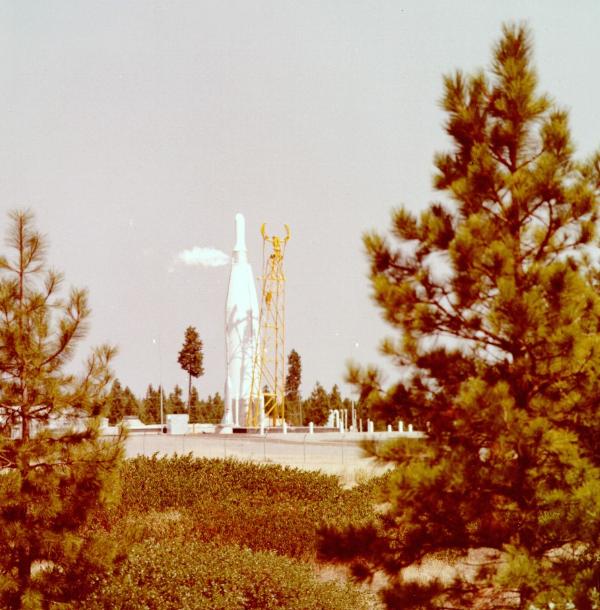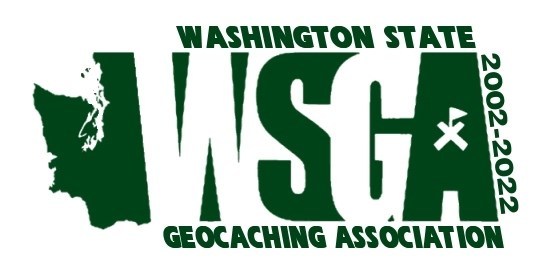Deer Park's Atlas I/C Ballistic Missile Multi-cache
Deer Park's Atlas I/C Ballistic Missile
-
Difficulty:
-

-
Terrain:
-

Size:  (regular)
(regular)
Please note Use of geocaching.com services is subject to the terms and conditions
in our disclaimer.
Deer Park's Atlas I/C Ballistic Missile
Cache is placed on the site of Deer Park's own
Atlas Intercontinental Ballistic Missile.
The coordinates above will take you to the starting point for this Missile Site Cache. There is parking available near the starting point, as no motorized vehicles are allowed on the trails leading to the cache. Round trip travel you will be looking at about 2 miles to complete this cache. Use of bicycles or horses is recommended, but you can walk too. In the winter this is a cross country ski area.
At the starting point you will need to find the answers to the following questions to make corrections to the "minutes" of the above coordinates.
N 47 58.ABC W117 24.XYZ
A= The length of Loop C (Miles). Add he two digits together.
B= The length of the Blue Loop (Miles). Subtract 1.5.
C= The last digit of the Boy Scout Troop #.
X= The length of Loop B (Kilometers). Add 0.4.
Y= Add the three digits of the Boy Scout Troop # together.
Z= The length of Loop A (Miles).
At the second point you will find the additional corrections you will need to make to the "minutes" for the coordinates to the final cache.
Good luck and enjoy the local military history this site has.
In the second week of January, 1959, the Deer Park Tribune announced that the rumors that began in the summer of `58 were no longer rumors. The Washington, D.C. office of congressman Walt Horan had called a press release in to the local newspaper saying the Air Force was indeed considering the local airport as a possible missile site. The plan called for three missile bases, with each base containing three missiles. Tentative sites for those bases would be near the towns of Davenport, Deer Park, and in the Long Lake area — with Fairchild Air Force Base as the hub. The peak of Dunns Mountain, located about eight miles west by southwest of Deer Park, was also to be purchased, presumably for some type of air defense or missile tracking device. The actual function of this proposed mountaintop installation remained secret.
By mid April, the military had released its latest plan revisions. The number of missiles per site had shrunk from three to one, while the number of sites in the Fairchild complex had expanded from three to nine. Deer Park and Reardon remained as sites. The Long Lake site was eliminated. Added to the list of sites were Newman Lake, Sprague, Lemona, Davenport, Wilbur, Egypt, and Rockford — although the Rockford site itself would be just over the Idaho state line. Though unexplained at the time, what had prompted the changes in the Air Force's plans were recent advances in the missile's design. The typical Atlas D group consisted of three missiles around a single launch control center — just as indicated in Congressman Horan's original message to the Deer Park Tribune. The Atlas D's onboard guidance system required ground tracking for flight corrections. Any corrections were calculated by a launch center computer, then radioed to the missile. The two problems with this system were its vulnerability to radio interference — natural and deliberate — and that the system could only handle one missile at a time — meaning a five minute minimum between each launch. Designated Atlas E, the newest version of the missile possessed an advanced onboard computer and inertial guidance system, and was totally autonomous from the moment of launch. The moment it lifted one inch skyward, it was independent of any ground communication — and, in fact, was incapable of receiving any. It was also becoming apparent that the base itself would be autonomous the moment it became operational. Nothing like a traditional military post, it had little to offer the community in the way of jobs or business. With that realization, the excitement began to fade. Little further mention of the missile could be found on the front page of the community newspaper until the fall of 1960. Despite the calm, much was going on. At a location about a mile east of the airport, construction began. Enough earth was excavated to allow most everything to be built below surface grade. Two main structures were laid out — a five thousand square foot launch control bunker, and about ten thousand square feet of bunker for the missile and related equipment. There was also over a hundred feet of tunnel to connect the two. One hundred and thirty thousand cubic yards of concrete, and almost thirty thousand tons of steel went into the eighteen inch thick walls, ceilings, and reinforced doors and hatches. Perhaps this lack of news about the construction was deliberate. After all, the finer details of the missiles and the nine bases surrounding Fairchild were a matter of military secrecy. The existence of the earlier version of the Atlas — the D model — was far from secret. It was the largest rocket in the American arsenal, and was on its way to becoming the nation's primary satellite launch vehicle — used to shoot a growing array of hardware into space, as well as being modified to lift the Mercury astronauts into orbit. Much of the military's involvement with the D series was taking place at California's Vandenberg Air Force Base, which was the training center for Atlas crews, and the location of the first successful all Air Force launch.
On December 6, 1960, a Cargomaster C-133B from Vandenberg dropped out of Fairchild’s cold winter sky carrying the first of the base’s compliment of Atlas missiles. Then, on a bright spring day at the end of March, 1961, a ground convoy transporting Deer Park’s Atlas left Fairchild for its first encounter with the town’s citizens. Traveling down the highway in the center of a six or more vehicle convoy bracketed by trucks with “Caution Wide Load” signs, the rocket couldn’t be missed. There wasn’t any pretence of secrecy to it. If a person somehow mistook the canvas covered body of the rocket for a silage silo or fuel tank, the outline of those three giant rocket nozzles protruding in a horizontal line across the back would leave no doubt. And the slow speeds necessary for moving any oversize object down a public highway, no more than forty miles an hour tops, certainly gave everyone plenty of time to gawk. “There were at least two Air Police vehicles in any highway convoy,” Jack Roberts said. “Those men were armed with carbines and handguns. An officer or NCO was in charge of the convoy, and usually had his own radio equipped command car. Usually there was a maintenance vehicle carrying Missile Maintenance Technicians or Ballistic Missile Analyst Technicians, their tools and tech orders — just in case any work was needed on the missile or its trailer. And normally we had some local cops as escorts.”

All nine of Fairchild’s Atlas E sites were built to the same blueprint. With the below grade portions of the bunkers identical, crews had no trouble adapting as they rotated between installations. All nine installations were also laid out to the same compass orientation. Referred to as a semi-hardened coffin bunker, the site’s below ground structures were designed to withstand a one megaton blast as close as a mile and a half. A detonation closer than this could potentially have put the site out of commission. In nuclear terms, neither the size nor proximity of such a detonation was particularly great. The military was well aware of the coffin bunker’s vulnerability. As the Atlas E’s sites were being brought into operation, construction had already begun on the next generation of Atlas ICBM’s, the hardened-silo based Atlas F series. Silos were superior to the Atlas E’s coffin bunkers in two respects. First, they were buried deeper, and could withstand a much greater shock. Secondly, the silo missiles were already standing upright. If launch commands were received, the missile would first be fueled, then the silo uncapped and the missile elevated aboveground and fired. With the coffin bunkers, the overhead blast door had to be retracted first, then the missile elevated from its reclining position, fueled, and fired. Prior to launch, the E series missiles were exposed above ground for a much longer period than the F series. On the other hand, the missiles housed in bunkers were not as prone to blowing up during fueling as the silo versions. Perhaps this was because the launch bay, open to the sky during fueling, allowed explosive fumes a greater chance to dissipate. Or perhaps this was because it was physically harder to carry out maintenance procedures in the deep, cramped confines of a silo. Two buildings made up the buried bunker portion of the Deer Park site. First, the launch operations building. This 54 by 90 foot building housed the launch control center, communications center, two offices, a mess hall, ready room, battery room, storage room, and power plant. Only equipment towers and the escape hatch extend above ground.
Between the 17th of February, and the 31st of March, 1965, all nine of Fairchild’s Atlas missiles bases were taken out of the defensive loop. By late June, with its official deactivation, the 567th Strategic Missile Squadron, its men and its mission, began their long slide into history. The missile itself continued to fly. As one of the nation’s most reliable launch vehicles for civilian and military orbital payloads, the Atlas continued well into the 1990’s, outliving the majority of its designers, and at least a few of the men who stood watch with it. As for the bunkers — the equipment was sold at auction and hauled away. Eventually the shell of the Deer Park bunker became a factory for manufacturing explosives used in open-pit mining. It will take centuries for the sheer mass of concrete used in Fairchild’s nine Atlas missile bunkers to crumble away, though the knowledge of what actually occurred there is already dissipating. Drawing mild curiosity, these monuments to the ‘cold war’ are already seen as irrelevant artifacts from another century.
| If you are a Geocacher in eastern Washington or northern Idaho, please join the Inland Empire Chapter of the Washington State Geocaching Association. This is a great way to get the most out of Geocaching in our region. Simply go to the WSGA Web Page for details! |
 |
2015 was the inaugural year of Spokane GeoTour. This Spokane County tour sent geocachers on a trip through Spokane History, finding caches in areas of historical significance. Visit urban and rural gems, historic farming communities, forts, geological marvels, and seek new adventures. The Spokane History GeoTour officially ended in spring of 2017 to make room for another tour; however, this cache remains and is still available to be found.

Additional Hints
(Decrypt)
Cbvag 1: Bhg va gur bcra sbe nyy gb frr. Cbvag 2: Nobhg n sbbg bss gur tebhaq. Svany: Qba'g yrg vg fghzc lbh.